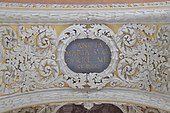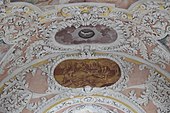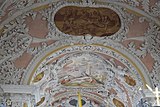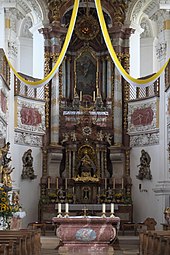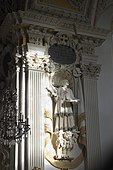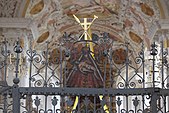To Our Lady of Sorrows (Vilgertshofen)
The Catholic branch and pilgrimage church of Our Lady of Sorrows in Vilgertshofen , a parish in the Bavarian district of Landsberg am Lech , was built in the Baroque style at the end of the 17th century . The church is decorated with rich Wessobrunn stucco and numerous ceiling frescos . It is the largest four-cone building in Bavaria and is one of the protected architectural monuments in Bavaria.
history
As early as the 10th century, the hamlet of Vilgertshofen had a chapel dedicated to St. Stephen . It was destroyed during the Hungarian invasion in 955 and, after being rebuilt, was consecrated to St. Ulrich of Augsburg . Around 1065/70 the chapel came into the possession of the Wessobrunn monastery through a donation , to which it was subordinate until the secularization in 1803. In 1281 the Wessobrunn abbot Ulrich III. build a church on the site of the chapel, which was consecrated to St. Stephen, St. Ulrich, Maria Magdalena and St. Afra of Augsburg . In 1284 Abbot Ulrich arranged for the financing of the church building that the Vilgertshofer church was granted special indulgence privileges for the anniversary of the church consecration and for the patronage festivals , which led to the beginning of the pilgrimage . The image of Our Lady of Sorrows has been venerated in the church since the middle of the 15th century .
In the first half of the 16th century, pilgrimages came to a standstill under the influence of the Reformation . After the Thirty Years War , the pilgrimage was revived. A new, larger church was built to accommodate the growing number of believers. The Wessobrunn monastery builder Johann Schmuzer was entrusted with the execution in 1686 , and the foundation stone was laid in 1687. In 1692 the new church was consecrated by the Augsburg auxiliary bishop Johannes Eustache Egolf von Westernach , only the towers were still unfinished. The Spanish War of Succession delayed the construction work, the south tower was not completed until 1732 by Joseph Schmuzer , the north tower was no longer built.
After the dissolution of the Wessobrunn monastery in 1803, the church fell to the Bavarian state, which wanted to have it torn down. The pilgrimages subsided and the church fell into disrepair. The residents of Vilgertshofen were only able to prevent the church from being demolished by taking over the construction work. After several renovations, the church was completely renovated between 1967 and 1976. In 1974 the pilgrimage was revived.
architecture
Exterior construction
The floor plan of the church corresponds to a Greek cross with rounded arms. The exterior is structured by Tuscan pilasters that stand on a high, all-round plinth. The walls are broken up by two-lane windows and at the bottom by four-pass windows. The south tower, which is covered with an onion dome, is structured by protruding cornices and has wide pilasters at the corners. Large arched windows open up on the bell storey, while three- and four-pass windows, arched windows and windows that are rounded up and down are cut into the lower part. Three portals are integrated into the semicircular vestibule to the west.
inner space
The large square crossing in the center of the interior is followed in the east by the two-storey, semicircular choir with double ambulatory , in the north and south semicircular arms equipped with altars and in the west a semicircular vestibule with organ loft. The walls are covered with fluted pilasters with Corinthian capitals , over which there is a cranked entablature and at the beginning of the vault a cornice resting on consoles . The choir and vestibule are covered by barrel vaults with stitch caps, the crossing has a flat barrel, the cross arms vaulting quarter spheres.
Piece
The Wessobrunn stucco decor dates from the time the church was built and was carried out by the master builder Joseph Schmuzer and his workshop. It consists of fruit pendants, cornucopia, flowers, leaves and shells as well as angel figures.
Ceiling frescoes
The total of 36 ceiling paintings depict scenes from the life of Mary , the story of Jesus' passion and episodes from the Old Testament. The oldest frescoes were done between 1693 and 1721, some were renewed in the 19th century.
The large ceiling fresco in the choir was done in 1721 by Johann Baptist Zimmermann . It shows Mary at the foot of the cross, the body of Jesus on her lap. God the Father hovers above the cross , the Holy Spirit is represented in the form of a dove with an olive branch. The ceiling painting over the crossing was replaced by Karl Manninger in 1976. The scene of the crucifixion of Christ is modeled on the baroque style.
Furnishing
- The two-story high altar made of stucco marble was created by Franz Xaver Schmuzer , the builder's son, between 1718 and 1721. The miraculous image of Our Lady of Sorrows is kept in a gilded shell niche in the lower altar , a colored, late Gothic carved figure.
- On the northern wall of the choir is the altar of the souls. The figures of angels and God the Father, some of which are set in gold, were probably made by Lorenz Luidl around 1715 . The late Gothic crucifix in the middle is dated around 1510/20.
- On the opposite side hangs a votive picture , a copy of the Maria-Hilf picture by Lukas Cranach .
- The Ulrichs altar in the northern cross arm is also a work by Franz Xaver Schmuzer from 1718. Bishop Ulrich von Augsburg and Emperor Otto I are depicted on the altar sheet. The two late Gothic figures on the cafeteria , St. Ulrich and St. Stephen, date from around 1460.
- The six-columned St. Stephen's altar in the southern transverse arm was created by Tassilo Zöpf in 1751 . The altar panel with the depiction of the stoning of St. Stephen is marked with the year 1770. It bears the signature of Johann Baptist Baader , who is also known as Lechmaler or Lechhansl . The white framed side figures of St. Afra von Augsburg and Maria Magdalena represent the church's secondary patrons. They were created in 1751 by Franz Xaver Schmädl .
- Next to the St. Stephen's altar is the altar of grace from the previous church, which was erected in 1671 as a temporary measure.
- The two figures in the choir arch niches, a Sorrowful Mother of God and a dungeon savior, are dated around 1720.
- The pulpit dates from the middle of the 18th century.
- In the niches of the crossing stand, framed by stucco curtains, ten larger than life, white-framed stucco figures from the time the church was built, depicting saints of the Benedictine order : Benedict of Nursia , the founder of the order, Pope Gregory the Great , Pope Urban II , Ildefons of Toledo, the Archbishop of Toledo , Rupert von Deutz , Beda Venerabilis , Anselm von Canterbury , Petrus Damiani , a cardinal and saint named Peter, the holy Scholastica of Nursia , the sister of Saint Benedict.
- The grid between the vestibule and the central room was commissioned in 1749. The Latin letters result in the sentence “O you painful mother, please for us!” The initials PRMW stand for the name of the founder, Father Rupert Mayr von Wessobrunn.
organ
The baroque organ by the organ builder Matthias Petz from Kaufbeuren was installed in 1694.
literature
- Georg Dehio : Handbook of the German art monuments. Bayern IV: Munich and Upper Bavaria . 2nd edition, Deutscher Kunstverlag, Munich 2002, ISBN 3-422-03010-7 , pp. 1227-1229.
- Karl Gattinger, Grietje Suhr: Landsberg am Lech, city and district (= Bavarian State Office for Monument Preservation [Hrsg.]: Monuments in Bavaria . Volume I.14 ). Verlag Friedrich Pustet, Regensburg 2014, ISBN 978-3-7917-2449-2 , p. 798-803 .
- Karin Schatke: Vilgertshofen. Pilgrimage Church of Our Lady of Sorrows . Peda Art Guide No. 623, Peda Art Publishing House, Passau 2005, ISBN 3-89643-623-6 .
Web links
- Pilgrimage church "To Our Lady of Sorrows of Vilgertshofen", Diocese of Augsburg (accessed on December 20, 2017)
Individual evidence
- ^ Branch of Mary Pain - Vilgertshofen Diocese of Augsburg
- ↑ Monument list for Vilgertshofen (PDF) at the Bavarian State Office for Monument Preservation, monument number D-1-81-133-20
Coordinates: 47 ° 57 '4.2 " N , 10 ° 55' 8.4" E




